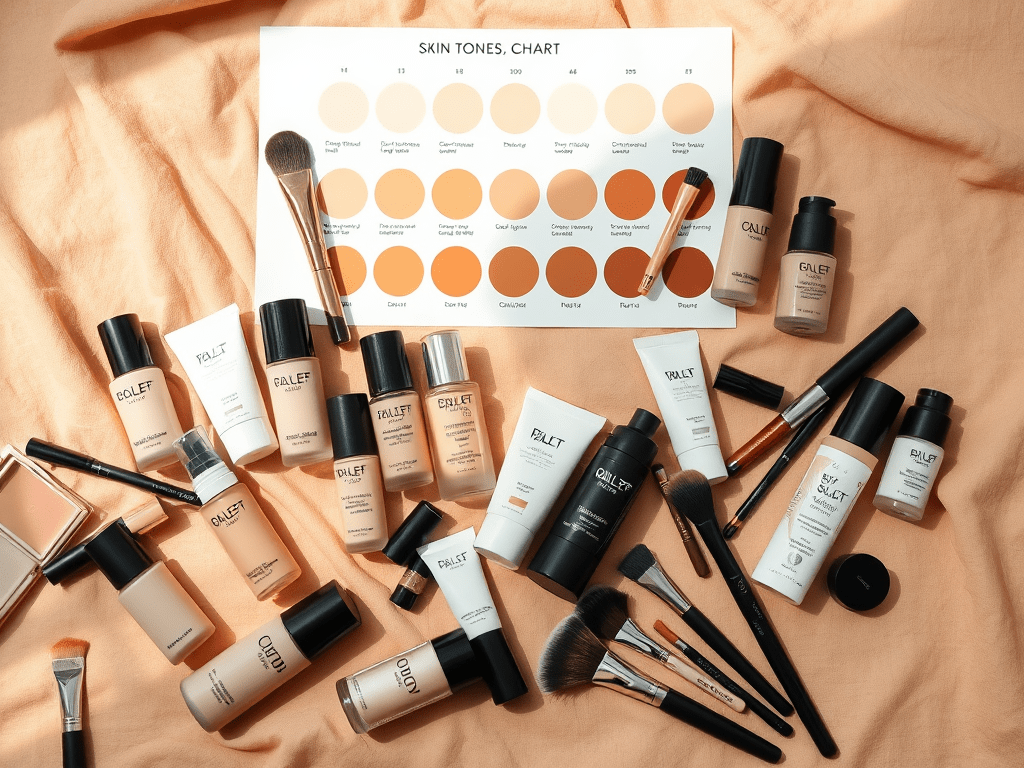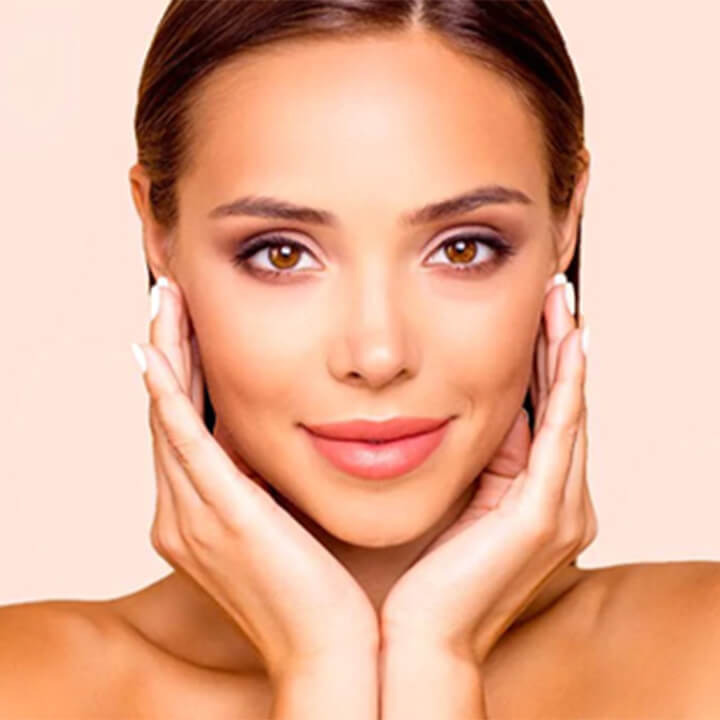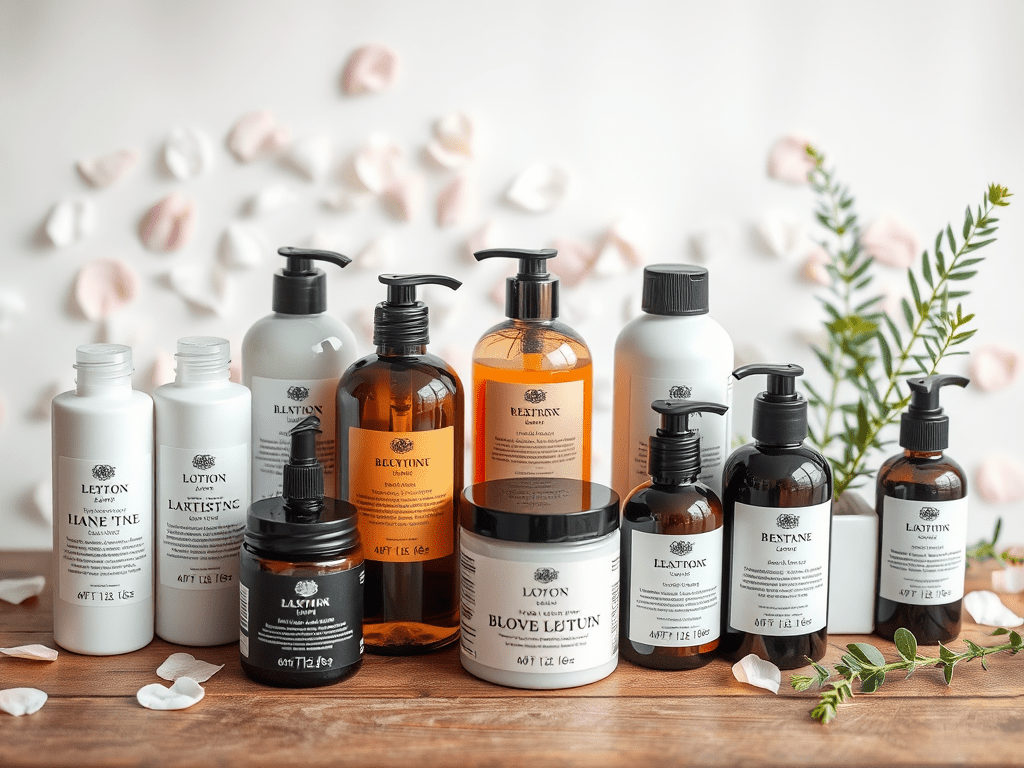
Radiant Skin Awakened: Discover the Transformative Power of Natural Ingredients
Understanding your skin undertone is crucial for selecting the perfect foundation, clothing, and accessories that harmonize with your unique complexion. This extensive guide will reveal effective methods to identify your skin undertone, helping you achieve a flawless makeup look while boosting your confidence.
Understanding Skin Undertones: A Guide to Finding Your Perfect Match
What Are Skin Undertones?
Skin undertones are the subtle hues that lie beneath the surface of your skin. These undertones can be classified as cool, warm, or neutral, and they play a crucial role in determining the most flattering colors and shades for your complexion.
Understanding your skin's undertone is essential for achieving a harmonious and natural-looking makeup application, as well as selecting the right clothing and accessories that complement your unique features.
- Skin undertones are not the same as your skin tone, which refers to the overall lightness or darkness of your skin.
- Undertones can influence the way certain colors and shades appear on your skin, making them either more flattering or less so.
- Knowing your undertone can help you make more informed choices when it comes to foundation, concealer, blush, and even hair color.
How to Determine if You Have Cool, Warm, or Neutral Undertones?
{Determining your skin's undertone can be a bit tricky, as it's not always obvious. However, there are a few simple methods you can use to figure it out.}
Here are some tips to help you identify your skin's undertone:
- Look at the veins on the inside of your wrist. If they appear more blue or purple, you likely have cool undertones. If they appear more green, you have warm undertones. If they appear a mix of both, you have neutral undertones.
- Consider how your skin reacts to the sun. If you tend to burn easily and have difficulty tanning, you likely have cool undertones. If you tan easily and don't burn as much, you have warm undertones. If you experience a mix of both, you have neutral undertones.
- Examine the jewelry you look best in. If silver and cooler-toned metals like platinum or white gold are more flattering, you have cool undertones. If gold and warmer-toned metals look better, you have warm undertones. If both look equally flattering, you have neutral undertones.
Determining your skin's undertone can take some trial and error, but it's worth the effort to ensure you're choosing products and colors that truly complement your natural beauty. Once you've identified your undertone, you can start building a makeup and wardrobe that makes you look and feel your absolute best.
What Methods Can Help You in Identifying Your Undertone?
{In addition to the classic methods mentioned earlier, there are a few other techniques you can use to pinpoint your skin's undertone.}
Here are some additional ways to determine your undertone:
- Look at the color of your skin in natural daylight. If your skin has more of a pinkish or reddish hue, you likely have cool undertones. If your skin has more of a yellow or golden hue, you have warm undertones. If your skin appears more neutral, with a mix of both pink and yellow, you have neutral undertones.
- Drape different colored fabrics or scarves around your face. Cool-toned colors like blues, pinks, and purples will typically look more flattering on those with cool undertones, while warmer shades like yellows, oranges, and reds will be more complementary for those with warm undertones. Neutral undertones can pull off a wide range of colors.
- Take a close look at your eye and hair color. Generally, those with cooler undertones tend to have blue, green, or gray eyes, and hair that ranges from blonde to dark brown or black. Those with warmer undertones often have hazel, brown, or amber eyes, and hair that is strawberry blonde, auburn, or dark brown. Neutral undertones can have a mix of both cool and warm features.
By exploring these various techniques, you can gain a clearer understanding of your skin's unique undertone. Embrace your natural beauty and let your undertone guide you to the most flattering colors and products that make you shine.
Unveiling the Secrets of Skin Undertone: A Comprehensive Guide
How Does a Skin Undertone Chart Work?
Skin undertone is a fundamental concept in the world of beauty and cosmetics. It refers to the subtle hues that lie beneath the surface of our skin, which can be categorized into three main types: warm, cool, and neutral. A skin undertone chart is a valuable tool that helps individuals identify their unique undertone, enabling them to make informed choices when it comes to selecting the right foundation, clothing, and even hair color.
Understanding the Skin Undertone Chart
- The skin undertone chart is a visual representation of the various undertones, typically displayed in a grid or color wheel format.
- Each undertone category is associated with a specific set of characteristics, such as the presence of yellow, pink, or olive tones in the skin.
- By examining the chart and comparing it to the appearance of your own skin, you can determine your predominant undertone, which can then guide your cosmetic and fashion choices.
Why is Understanding Undertones Key to Choosing Foundation?
Choosing the right foundation is a crucial step in achieving a flawless, natural-looking complexion. However, this task can be daunting, especially when faced with the vast array of shades and formulas available in the market. This is where understanding your skin undertone becomes essential.
Matching Foundation to Your Undertone
- Foundations that complement your undertone will seamlessly blend with your skin, creating a harmonious and unified appearance.
- Conversely, choosing a foundation that does not match your undertone can result in a mismatch, where the foundation appears to sit on top of the skin rather than blending in.
- By identifying your undertone and selecting a foundation that aligns with it, you can ensure a smooth, even, and natural-looking finish.
The Importance of Undertone in Makeup Application
- Undertone plays a crucial role in determining the most flattering shades of blush, bronzer, and even eye shadow.
- Warm-toned individuals may find that cooler-toned makeup products can appear unflattering or unnatural on their skin.
- Understanding your undertone allows you to curate a makeup routine that enhances your natural features and complements your complexion.
What Are the Benefits of Using an Undertone Chart?
Utilizing a skin undertone chart offers numerous benefits that can transform your beauty routine and boost your confidence.
Achieving a Flawless Complexion
- By identifying your undertone and selecting products that harmonize with it, you can create a seamless, natural-looking complexion.
- This attention to detail ensures that your makeup blends effortlessly, minimizing the appearance of any visible lines or boundaries.
- Ultimately, a well-matched foundation can enhance your features, leaving you with a radiant and youthful glow.
Streamlining Your Makeup Routine
- Knowing your undertone simplifies the process of finding the right shades and formulas for your skin.
- This knowledge can help you quickly navigate the overwhelming selection of makeup products, saving you time and frustration.
- With a clear understanding of your undertone, you can confidently build a makeup collection that works in harmony with your natural features.
Boosting Self-Confidence
- Feeling comfortable and confident in your own skin is a powerful thing.
- When you know how to choose products that complement your undertone, you can approach your beauty routine with a sense of ease and assurance.
- This confidence can translate into a more positive self-image and an enhanced overall appearance.
Understanding your skin undertone is a game-changer in the world of beauty. By utilizing a comprehensive skin undertone chart, you can unlock the secrets to achieving a flawless complexion, streamlining your makeup routine, and ultimately, boosting your self-confidence. Embrace the power of this knowledge and elevate your beauty journey to new heights.
Unlock the Secret to Flawless Complexion: A Guide to Choosing the Perfect Foundation
What Factors to Consider When Selecting Foundation?
When it comes to achieving a flawless complexion, the foundation you choose can make all the difference. However, with the myriad of options available in the market, it can be overwhelming to select the right one. Fear not, as we delve into the key factors you should consider when choosing your perfect foundation.
Skin Type and Tone
- Determine your skin type, whether it's dry, oily, or combination, as this will help you select the appropriate formula.
- Identify your skin tone, whether it's fair, medium, or deep, and choose a foundation that seamlessly blends with your natural complexion.
- Consider your undertone as well, which can be warm, cool, or neutral, and select a foundation that complements this.
Coverage and Finish
- Decide on the level of coverage you desire, from sheer to full, depending on your skin concerns and desired look.
- Opt for a finish that suits your preference, whether it's matte, satin, or dewy, to achieve the desired effect on your skin.
Undertone and Color Match
- Ensure the foundation you choose has the right undertone to avoid any unwanted orange or ashy tones on your skin.
- Test the foundation on your jawline or neck to ensure a seamless, natural-looking blend.
Ingredients and Formulation
- Scan the ingredient list to ensure the foundation is free from any ingredients that may cause irritation or clogged pores.
- Consider the formulation, whether it's liquid, cream, or powder, and choose the one that best suits your skin type and needs.
How to Test Foundation on Your Skin?
Selecting the perfect foundation is a delicate balance, and it's essential to test it thoroughly before making a purchase. Here's a step-by-step guide to ensure you find the right fit for your skin.
Sample Application
- When testing a foundation, apply a small amount to the back of your hand or your jawline.
- Blend the foundation well, ensuring it's fully absorbed into your skin.
Observe the Undertone and Color Match
- Examine the foundation in natural lighting to see how it blends with your skin tone and undertone.
- Check for any oxidation or color changes as the foundation sets on your skin.
Wear Test
- Apply the foundation to your entire face and wear it for at least 30 minutes to an hour.
- Observe how the foundation wears throughout the day, checking for any creasing, separating, or fading.
Consider Your Skin's Reaction
- Monitor your skin for any signs of irritation, such as redness, itchiness, or breakouts.
- Ensure the foundation doesn't accentuate any dry patches or highlight fine lines and pores.
Trust Your Instincts
- If the foundation doesn't feel or look right, trust your instincts and move on to the next option.
- The perfect foundation should make you feel confident and comfortable in your own skin.
What Are Common Mistakes to Avoid During Foundation Selection?
Selecting the right foundation can be a daunting task, and it's easy to make mistakes along the way. To ensure you avoid common pitfalls, here are some tips to keep in mind.
Ignoring Your Skin Type
- Applying the wrong foundation formula for your skin type can lead to an unflattering, cakey, or uneven appearance.
- Always consider your skin type and choose a formula that caters to your specific needs.
Skipping the Shade Test
- Assuming your foundation shade based on your past purchases or online recommendations can result in a poor color match.
- Always swatch and test the foundation shades on your skin to ensure a seamless, natural-looking blend.
Applying in Artificial Lighting
- Testing a foundation in harsh, artificial lighting can lead to an inaccurate assessment of the color and finish.
- Conduct your foundation testing in natural lighting to get a true representation of how it will look on your skin.
Ignoring Undertones
- Focusing solely on the surface color of a foundation can lead to a mismatch with your undertone.
- Pay close attention to the undertone of the foundation, ensuring it complements your skin's undertone.
Forgetting the Wear Test
- Rushing into a purchase without thoroughly testing the foundation's wear and performance can lead to disappointment.
- Always conduct a wear test to evaluate the foundation's longevity, oil control, and ability to maintain a flawless look throughout the day.
Selecting the perfect foundation is a journey, but with the right knowledge and approach, you can unlock the secret to a flawless, radiant complexion. Remember to consider your skin type, undertone, and desired coverage, as well as thoroughly test the foundation before making a purchase. By avoiding common mistakes and following these guidelines, you'll be on your way to achieving a complexion that truly reflects your best self.
Radiant Skin Awakened: Discover the Transformative Power of Natural Ingredients
Organic Chocolate Cherry Anti-Aging Face Mask 🍒🍫
This rejuvenating anti-aging face mask helps tired, dull skin to GLOW, using the manifold benefits of cherry juice and raw cocoa powder. The combination of ingredients in this anti-aging face mask does wonders for your skin.
Unlock the Secret to Youthful, Radiant Skin
- Cherry juice is known to lighten skin and clear dark spots, while its anti-inflammatory properties treat acne and rosace.
- Cherries are moisturizing and rich in antioxidants, safeguarding skin and counteracting signs of aging.
- Cocoa is packed with antioxidants and vitamins to promote cellular healing, and its blood-flow boosting properties yield a firmer, youthful complexion with a radiant sheen.
- This mask gently exfoliates to reveal a brighter, more even-toned complexion.
- The nourishing formula leaves skin feeling soft, supple, and deeply hydrated.
Organic Papaya and Pineapple Enzyme Face Mask 🥭🍍
Our organic face mask contains essential vitamins and enzymes to help achieve a luminous look. Botanical extracts in the formula act like mild hydrators, rejuvenating your complexion.
Unveil a Brighter, More Youthful Glow
- Papaya helps to encourage cell turnover, revealing a fresh, radiant complexion.
- Pineapple has skin-purifying, cleansing, and protective benefits, leaving your skin feeling refreshed and renewed.
- The proprietary blend of natural ingredients will exfoliate to diminish lines and wrinkles, even out skin tone, and contribute to a natural lift.
- This mask provides deep hydration, leaving your skin with a silky-smooth texture.
- The natural enzymes work to gently break down dead skin cells, revealing a brighter, more even-toned complexion.
Organic Pumpkin & Flaxseed Enzyme Face Mask 🎃💫
Try this luxurious organic pumpkin & flaxseed facial mask that gently exfoliates, brightens & tightens skin which encourages skin cell regeneration, decreases the appearance of fine lines and wrinkles and helps to remove discolorations that leave your skin tone uneven. Your skin will have a super hydrated, youthful feel.
Revitalize and Rejuvenate Your Complexion
- Pumpkins are rich in Vitamins A and C and various enzymes that help nourish and brighten skin.
- Pumpkin, Flaxseed, Agave, Coconut & Lemon Juice work in combination to help brighten skin and treat a dull complexion.
- This mask gently exfoliates to reveal a smoother, more radiant complexion.
- The hydrating formula leaves skin feeling plump, supple, and youthful.
- The natural enzymes in this mask work to refine pores and minimize the appearance of fine lines and wrinkles.
With these transformative organic face masks, you can unlock the secrets to youthful, radiant skin. Infused with powerful natural ingredients, each mask targets specific skin concerns to deliver unparalleled results. Indulge in the luxurious experience and let your complexion be the canvas for a truly enchanting glow. 🤩 Discover the power of nature and let your skin shine with Simply Radiant Beauty!
Q&A
What are skin undertones?
Skin undertones are the subtle hues beneath the skin's surface, categorized as cool, warm, or neutral. They influence how colors appear on your skin and are essential for choosing flattering makeup and clothing.
How can I determine my skin undertone?
You can determine your skin undertone by checking the color of your veins, observing how your skin reacts to the sun, and noticing which metals in jewelry complement your features best.
Why is it important to match foundation to my undertone?
Matching foundation to your undertone ensures a seamless blend, creating a natural, flattering look without any harsh lines or dissonance between your skin and makeup.
What is a skin undertone chart?
A skin undertone chart visually represents the various undertones (warm, cool, neutral) and their associated characteristics, helping individuals identify their own undertone for better cosmetic choices.
What common mistakes should I avoid when selecting foundation?
Common mistakes include ignoring your skin type, skipping shades tests, testing in artificial lighting, overlooking undertones, and failing to conduct wear tests before purchasing.
By understanding your skin undertone and utilizing the right methods to determine it, you can elevate your makeup routine and embrace your natural beauty. Say goodbye to mismatched foundations and hello to a more confident you.










